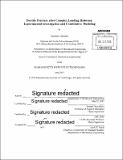Ductile fracture after complex loading histories : experimental investigation and constitutive modeling
Author(s)
Marcadet, Stephane (Stephane Jean Marie)
DownloadFull printable version (17.91Mb)
Other Contributors
Massachusetts Institute of Technology. Department of Mechanical Engineering.
Advisor
Tomasz Wierzbicki and David E. Hardt.
Terms of use
Metadata
Show full item recordAbstract
In engineering practice, sheet metal often fails after complex strain paths that deviate substantially from the widely studied proportional loading paths. Different from previous works on the ductile fracture of sheet metal, this thesis research addresses the experimental and modeling issues related to the crack initiation in advanced high strength steels after loading direction reversal. The main outcome of the present work is a fracture initiation model for proportional and non-proportional loading. The starting point of this thesis is a first chapter on the development of a micromechanically-motivated ductile fracture initiation model for metals for proportional loading. Its formulation is based on the assumption that the onset of fracture is imminent with the formation of a primary or secondary band of localization. Motivated by the results from a thorough unit cell analysis, it is assumed that fracture initiates after proportional loading if the linear combination of the Hosford equivalent stress and the normal stress acting on the plane of maximum shear reaches a critical value. A comprehensive fracture initiation model is then obtained after transforming the localization criterion from the stress space to the space of equivalent plastic strain, stress triaxiality and Lode angle parameter using the material's isotropic hardening law. Experimental results are presented for three different advanced high strength steels. For each material, the onset of fracture is characterized for five distinct stress states, including butterfly shear, notched tension, tension with a central hole, and punch experiments. The comparison of model predictions with the experimental results demonstrates that the proposed Hosford-Coulomb model can predict with satisfactory accuracy the instant of ductile fracture initiation in advanced high strength steels. In a subsequent chapter, experimental methods are developed to perform compression tension experiments. In addition, a finite strain constitutive model is proposed combining a Swift-Voce isotropic hardening law with two Frederick-Armstrong kinematic hardening rules and a Yoshida-Uemori type of hardening stagnation approach. The plasticity model parameters are identified from uniaxial tension-compression stress-strain curve measurements and finite element simulations of compression-tension experiments on notched specimens. The model predictions are validated through comparison with experimentally-measured load-displacement curves up to the onset of fracture, local surface strain measurements and longitudinal thickness profiles. The extracted loading paths to fracture show a significant increase in ductility as a function of the compressive pre-strain. The Hosford-Coulomb model is therefore integrated into a non-linear damage indicator modeling framework to provide a phenomenological description of the experimental results for monotonic and reverse loading. Another extension of the modeling framework is presented in a third chapter inspired by the results from loss of ellipticity analysis. It is demonstrated that the Hosford-Coulomb model can also be expressed in terms of a stress-state dependent critical hardening rate. Moreover, it is shown that the critical hardening rate approach provides accurate predictions of the instant of fracture initiation for both proportional and non-proportional loading conditions. Enhancements of the finite strain constitutive model are also proposed to enable a fast identification of all model parameters. The plasticity model parameters are identified from stress-strain curve measurements from shear loading reversal on specimens with a uniform thickness reduced gage section. The model is used to estimate the local strain and stress fields in fracture experiments after shear reversal. The extracted loading paths to fracture show a significant increase in ductility as a function of the strain at shear reversal, a feature that is readily predicted by the prosed critical hardening rate model.
Description
Thesis: Ph. D., Massachusetts Institute of Technology, Department of Mechanical Engineering, 2015. Cataloged from PDF version of thesis. Includes bibliographical references (pages 161-173).
Date issued
2015Department
Massachusetts Institute of Technology. Department of Mechanical EngineeringPublisher
Massachusetts Institute of Technology
Keywords
Mechanical Engineering.